用 IaC 创建云资源
本指南只需 8 分钟即可完成,旨在展示以下内容:
- 使用 IaC 创建资源的完整流程。
- 从自助操作后端与 Port 进行通信的简便性。
- 本指南假定您已拥有 Port 账户,并已完成onboarding process 。我们将使用Onboarding过程中创建的 "服务 "蓝图。
- 您需要一个 Git 仓库(Github、GitLab 或 Bitbucket),您可以在其中放置我们将在本指南中使用的工作流/Pipelines。如果没有,建议创建一个名为 "Port-actions "的新仓库。
本指南的目标
在本指南中,我们将在 Port 内部的 Git 仓库中打开一个拉取请求,使用 gitops 创建一个新的云资源。
完成这项工作后,你就会了解它如何使你的组织中的不同角色受益:
- 平台工程师将能够定义强大的操作,开发人员可在受控的权限范围内使用这些操作。
- 开发人员将能从 Port 轻松创建和跟踪云资源。
在新资源定义中添加 URL
在本指南中,我们将在 service蓝图中添加一个新属性,我们可以用它来访问我们的云资源定义。
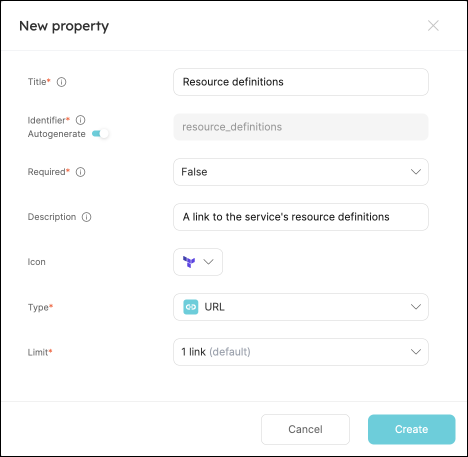
在所有服务中,该属性暂时为空,我们将在接下来创建的操作中填充该属性 😎
设置动作的前端
- 前往 Port 应用程序中的Self-service tab ,点击 "+ 新操作"。
- Port 中的每个操作都与蓝图直接相关。我们的操作将创建一个与服务相关联的资源,并作为服务 CD 流程的一部分进行供应。
从下拉列表中选择 "服务"。 3.此操作不会创建/删除实体,而是对现有实体执行操作。因此,我们将选择Day-2作为操作类型。
像这样填写表格,然后单击 "下一步":
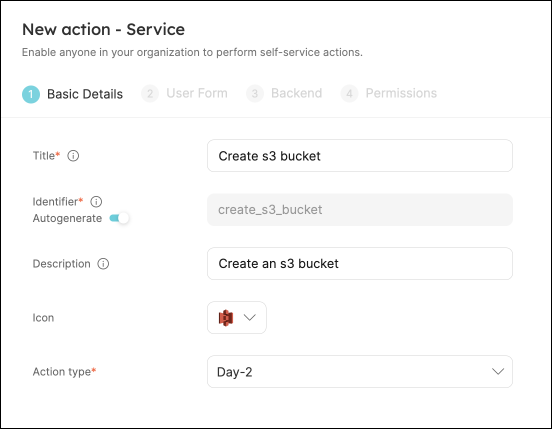
4.我们希望使用此操作的开发人员能指定简单的输入,而不是被 S3 存储桶的所有可用配置弄得不知所措。对于此操作,我们将定义一个名称和公共/私有可见性。
点击 "+ 新输入",像这样填写表格,然后点击 "创建":
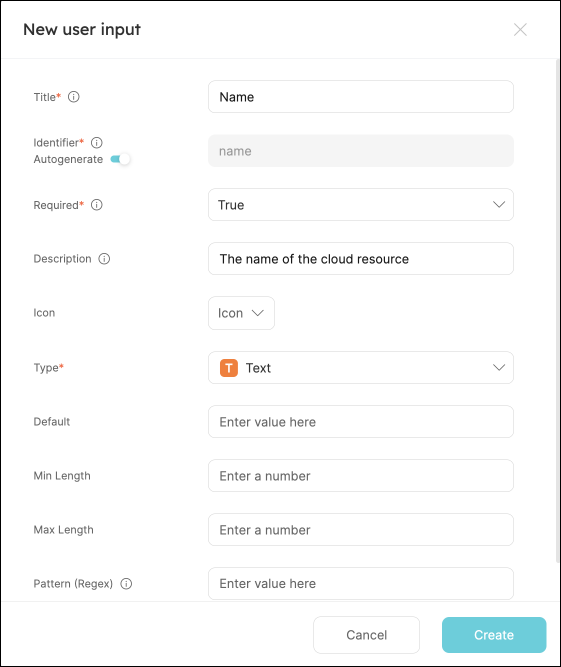
5.现在让我们创建可见性输入,它稍后将作为我们资源的 acl。
点击 "+ 新输入法",像这样填写表格,然后点击 "创建":
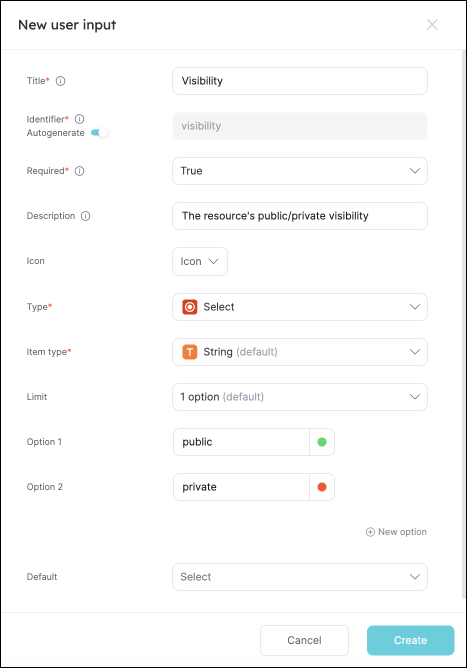
6.现在我们来定义动作的后端。Port 支持多种调用类型,根据您在入门流程开始时选择的 Git Providers,我们会为您选择其中一种。
- GitHub
- GitLab
- Bitbucket (Jenkins)
在表格中填写您的 Values:
- 用您的 Values 替换
Organization和Repository值(这是工作流将驻留和运行的位置)。 - 将工作流命名为
portCreateBucket.yaml。 - 将 "忽略用户输入 "设置为 "是"。
- 像这样填写表��单的其余部分,然后单击
下一步:
在我们的工作流程中,有效载荷被用于为输入。 为了避免向工作流程发送额外的输入,我们省略了用户输入。
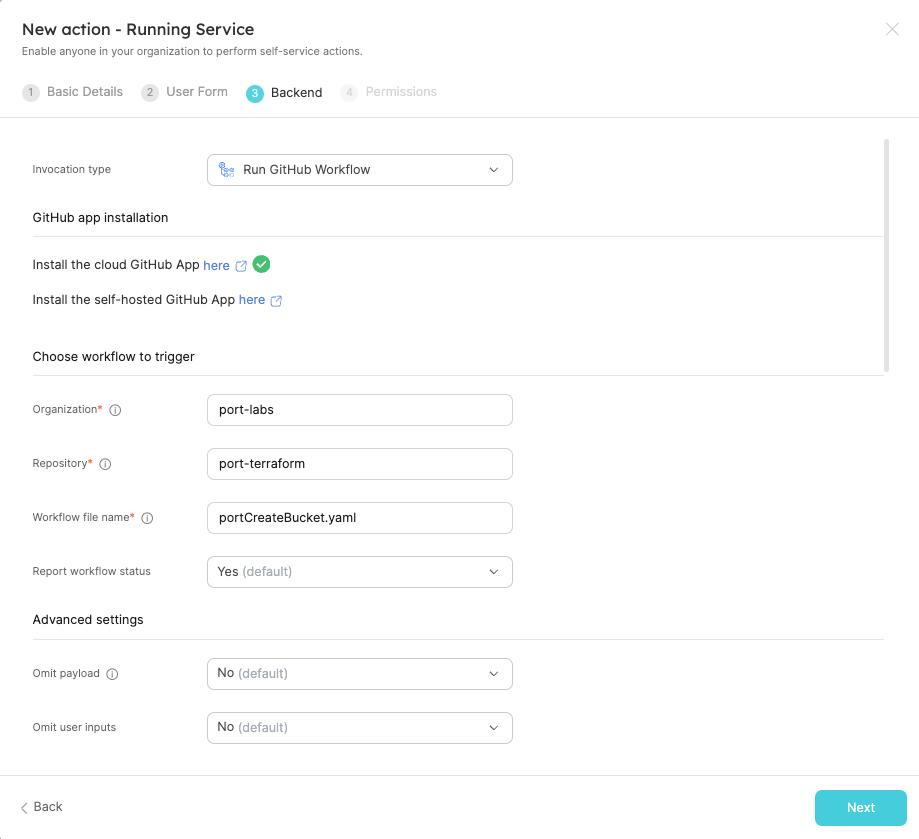
在表格中填�写您的 Values:
-
端点 URL "需要添加以下格式的 URL:
https://gitlab.com/api/v4/projects/{GITLAB_PROJECT_ID}/ref/main/trigger/pipeline?token={GITLAB_TRIGGER_TOKEN}- The value for
{GITLAB_PROJECT_ID}is the ID of the GitLab group that you create in the setup the action's backend section which stores the.gitlab-ci.ymlpipeline file.- To find the project ID, browse to the GitLab page of the group you created, at the top right corner of the page, click on the vertical 3 dots button (next to
Fork) and selectCopy project ID
- To find the project ID, browse to the GitLab page of the group you created, at the top right corner of the page, click on the vertical 3 dots button (next to
- The value for
{GITLAB_TRIGGER_TOKEN}is the trigger token you create in the setup the action's backend section.
- The value for
- Set
HTTP methodtoPOST. - Set
Request typetoAsync. - Set
Use self-hosted agenttoNo.
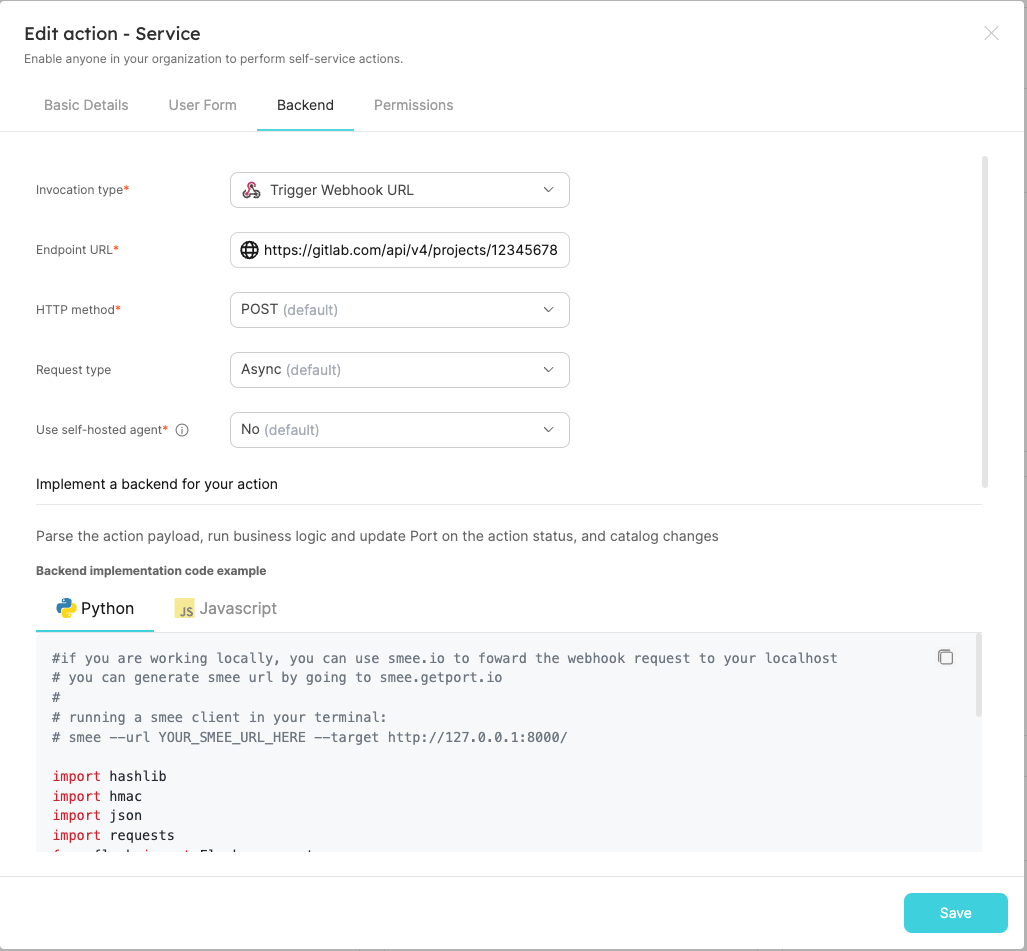
Bitbucket 要求在操作中定义另一个输入。 创建以下输入:
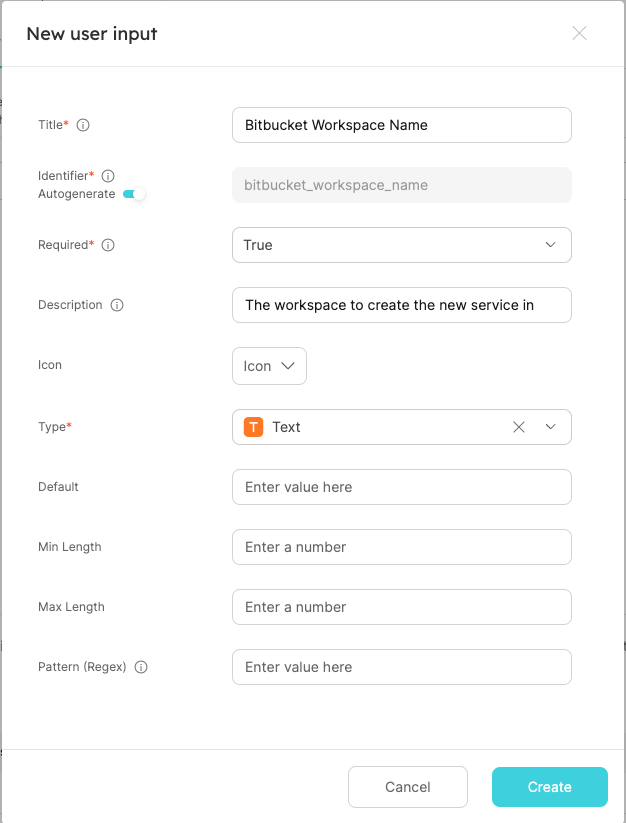
在表格中填写您的 Values:
-
端点 URL "需要添加以下格式的 URL:
https://{JENKINS_URL}/generic-webhook-trigger/invoke?token={JOB_TOKEN}- The value for
{JENKINS_URL}is the URL of your Jenkins server. - The value for
{JOB_TOKEN}is the unique token used to trigger the pipeline you create in the setup the action's backend section.
- The value for
- Set
HTTP methodtoPOST. - Set
Request typetoAsync. - Set
Use self-hosted agenttoNo.
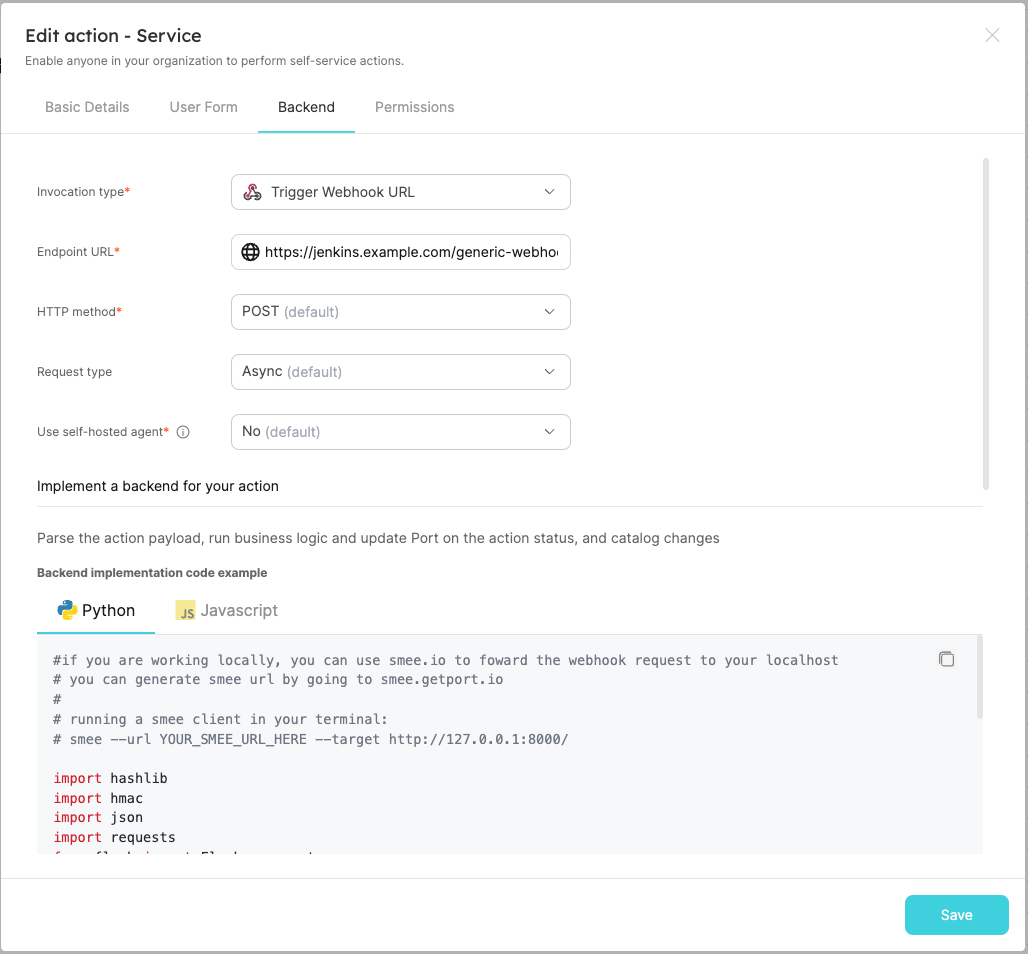
7.最后一步是自定义操作权限。为简单起见,我们将被用于默认设置。更多信息,请参阅permissions 页面。单击 "创建"。
action的前端已准备就绪 🥳
设置action的后端
现在,我们要编写我们的操作将触发的逻辑。
- GitHub
- GitLab
- Bitbucket (Jenkins)
- First, let's create the necessary token and secrets. If you've already completed the scaffold a new service guide, you should already have these configured and you can skip this step.
- 访问Github tokens page ,创建一个包含
repo和admin:org范围的个人访问令牌,并将其复制(从我们的工作流中创建拉取请求需要此令牌) 。 - 访问Port application ,点击右上角的"...",然后点击 "凭据"。复制您的
- 访问Port application ,点击右上角的"...",然后点击 "凭据"。复制您的 客户 ID和客户 secret。
2.在工作流程所在的版本库中,在 "设置->secret和变量->操作 "下创建 3 个新secret:
- ORG_ADMIN_TOKEN` - 您在上一步中创建的个人访问令牌。
PORT_CLIENT_ID- 从 Port 应用程序复制的客户端 ID。- PORT_CLIENT_SECRET` - 从 Port 应用程序复制的客户机secret。

3.现在,让我们创建包含逻辑的工作流程文件。我们的工作流程将包括 3 个步骤:
- 在所选服务的资源库中创建模板文件副本,并用操作输入的数据替换其中的变量。
- 在选定服务的资源库中创建拉取请求,添加新资源。
- 向 Port 报告和记录操作结果,并使��用服务资源目录的 URL 更新相关服务的 "资源定义 "属性。
在.github/workflows/下创建一个名为portCreateBucket.yaml的新文件,并使用以下代码段作为其内容:
Github workflow (click to expand)
name: Create cloud resource
on:
workflow_dispatch:
inputs:
name:
type: string
visibility:
type: string
port_payload:
required: true
description: Port's payload, including details for who triggered the action and general context
type: string
jobs:
createResource:
runs-on: ubuntu-latest
steps:
- uses: actions/checkout@v3
- uses: actions/checkout@v3
with:
repository: "${{ github.repository_owner }}/${{fromJson(inputs.port_payload).context.entity}}"
path: ./targetRepo
token: ${{ secrets.ORG_ADMIN_TOKEN }}
- name: Copy template file
run: |
mkdir -p ./targetRepo/resources
cp templates/cloudResource.tf ./targetRepo/resources/${{ inputs.name }}.tf
- name: Update new file data
run: |
sed -i 's/{{ bucket_name }}/${{ inputs.name }}/' ./targetRepo/resources/${{ inputs.name }}.tf
sed -i 's/{{ bucket_acl }}/${{ inputs.visibility }}/' ./targetRepo/resources/${{ inputs.name }}.tf
- name: Open a pull request
uses: peter-evans/create-pull-request@v5
with:
token: ${{ secrets.ORG_ADMIN_TOKEN }}
path: ./targetRepo
commit-message: Create new resource - ${{ inputs.name }}
committer: GitHub <[email protected]>
author: ${{ github.actor }} <${{ github.actor }}@users.noreply.github.com>
signoff: false
branch: new-resource-${{ inputs.name }}
delete-branch: true
title: Create new resource - ${{ inputs.name }}
body: |
Create new ${{ inputs.visibility }} resource - ${{ inputs.name }}
draft: false
create-entity-in-port-and-update-run:
runs-on: ubuntu-latest
needs: createResource
steps:
- name: UPSERT Entity
uses: port-labs/port-github-action@v1
with:
identifier: ${{fromJson(inputs.port_payload).context.entity}}
blueprint: service
properties: |-
{
"resource_definitions": "${{ github.server_url }}/${{ github.repository_owner }}/${{fromJson(inputs.port_payload).context.entity}}/blob/main/resources/"
}
clientId: ${{ secrets.PORT_CLIENT_ID }}
clientSecret: ${{ secrets.PORT_CLIENT_SECRET }}
operation: UPSERT
runId: ${{fromJson(inputs.port_payload).context.runId}}
- name: Create a log message
uses: port-labs/port-github-action@v1
with:
clientId: ${{ secrets.PORT_CLIENT_ID }}
clientSecret: ${{ secrets.PORT_CLIENT_SECRET }}
operation: PATCH_RUN
runId: ${{fromJson(inputs.port_payload).context.runId}}
logMessage: Pull request created successfully for "${{ inputs.name }}" 🚀
- 首先,让我们创建一个 GitLab 项目,存储我们新的水桶创建管道--进入 GitLab 账户,创建一个新项目。
- 接下来,创建必要的 token 和 secrets:
- 进入Port application ,点击右上角的"...",然后点击 "凭据"。复制 "客户 ID "和 "客户 secret"。
- 访问project ,按照here 的步骤创建一个新的项目访问令牌,其权限范围如下:
write_repository,然后保存其值,因为下一步将需要它。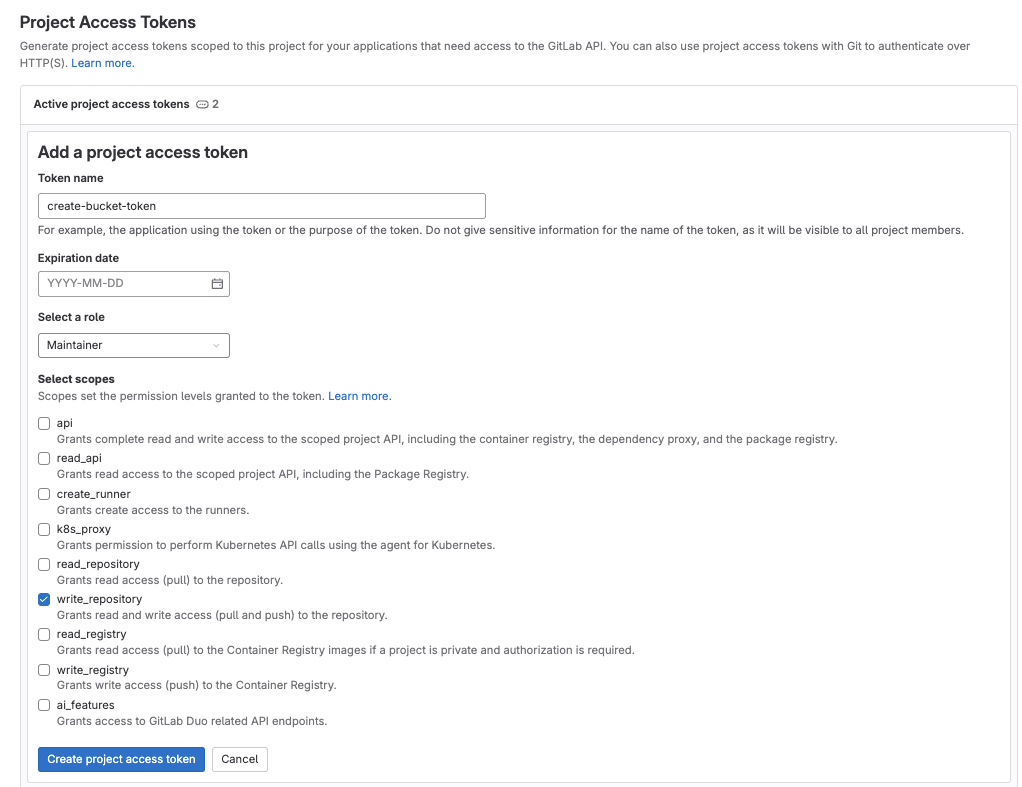
- 转到步骤 1 中创建的新 GitLab 项目,在左侧边栏的 "设置 "菜单中选择 "CI/CD"。
- 展开 "变量 "部分,保存以下secret:
PORT_CLIENT_ID- 您的 Port 客户端 ID。PORT_CLIENT_SECRET- 您的 Port 客户端secret。GITLAB_ACCESS_TOKEN- 在上一步中创建的 GitLab 组访问令牌。
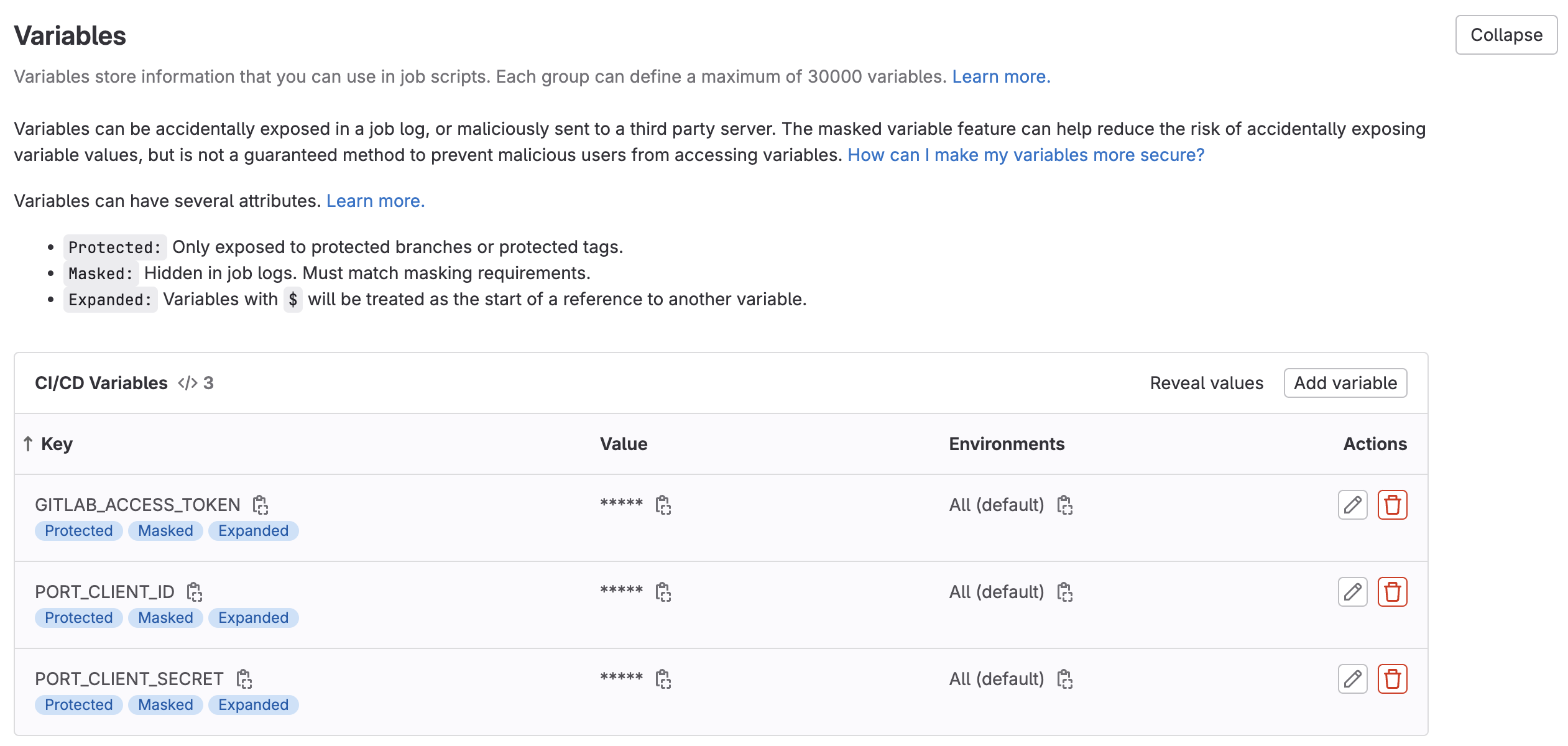
- 展开 "Pipelines 触发令牌 "部分并添加一个新令牌,给它一个有意义的描述,如 "Bucket 创建者令牌",并保存其值
- 这就是定义 Action 后端所需的
{GITLAB_TRIGGER_TOKEN}。
- 这就是定义 Action 后端所需的

3.现在让我们创建包含逻辑的 Pipelines 文件。在步骤 1 创建的新 GitLab 项目中,在项目根目录下创建一个名为 .gitlab-ci.yml的新文件,并将以下代码段作为其内容:
GitLab pipeline (click to expand)
image: python:3.10.0-alpine
stages: # List of stages for jobs, and their order of execution
- fetch-port-access-token
- create-tf-resource-pr
- create-entity
- update-run-status
fetch-port-access-token: # Example - get the Port API access token and RunId
stage: fetch-port-access-token
except:
- pushes
before_script:
- apk update
- apk add jq curl -q
script:
- |
echo "Getting access token from Port API"
accessToken=$(curl -X POST \
-H 'Content-Type: application/json' \
-d '{"clientId": "'"$PORT_CLIENT_ID"'", "clientSecret": "'"$PORT_CLIENT_SECRET"'"}' \
-s 'https://api.getport.io/v1/auth/access_token' | jq -r '.accessToken')
echo "ACCESS_TOKEN=$accessToken" >> data.env
runId=$(cat $TRIGGER_PAYLOAD | jq -r '.context.runId')
echo "RUN_ID=$runId" >> data.env
curl -X POST \
-H 'Content-Type: application/json' \
-H "Authorization: Bearer $accessToken" \
-d '{"message":"🏃♂️ Starting S3 bucket creation process..."}' \
"https://api.getport.io/v1/actions/runs/$runId/logs"
curl -X PATCH \
-H 'Content-Type: application/json' \
-H "Authorization: Bearer $accessToken" \
-d '{"link":"'"$CI_PIPELINE_URL"'"}' \
"https://api.getport.io/v1/actions/runs/$runId"
artifacts:
reports:
dotenv: data.env
create-tf-resource-pr:
before_script: |
apk update
apk add jq curl git -q
stage: create-tf-resource-pr
except:
- pushes
script:
- |
git config --global user.email "[email protected]"
git config --global user.name "Bucket Creator"
git config --global init.defaultBranch "main"
git clone https://:${GITLAB_ACCESS_TOKEN}@gitlab.com/${CI_PROJECT_NAMESPACE}/${CI_PROJECT_NAME}.git sourceRepo
cat $TRIGGER_PAYLOAD
git clone https://:${GITLAB_ACCESS_TOKEN}@gitlab.com/${CI_PROJECT_NAMESPACE}/$(cat $TRIGGER_PAYLOAD | jq -r '.context.entity').git targetRepo
- |
bucket_name=$(cat $TRIGGER_PAYLOAD | jq -r '.payload.properties.name')
visibility=$(cat $TRIGGER_PAYLOAD | jq -r '.payload.properties.visibility')
echo "BUCKET_NAME=${bucket_name}" >> data.env
echo "Creating a new S3 bucket Terraform resource file"
mkdir -p targetRepo/resources/
cp sourceRepo/templates/cloudResource.tf targetRepo/resources/${bucket_name}.tf
sed -i "s/{{ bucket_name }}/${bucket_name}/" ./targetRepo/resources/${bucket_name}.tf
sed -i "s/{{ bucket_acl }}/${visibility}/" ./targetRepo/resources/${bucket_name}.tf
- |
cd ./targetRepo
git add resources/${bucket_name}.tf
git commit -m "Added ${bucket_name} resource file"
git checkout -b new-bucket-branch-${bucket_name}
git push origin new-bucket-branch-${bucket_name}
PROJECT_NAME=$(cat $TRIGGER_PAYLOAD | jq -r '.context.entity | @uri')
PROJECTS=$(curl --header "PRIVATE-TOKEN: $GITLAB_ACCESS_TOKEN" "https://gitlab.com/api/v4/groups/$CI_PROJECT_NAMESPACE_ID/projects?search=$(cat $TRIGGER_PAYLOAD | jq -r '.context.entity')")
PROJECT_ID=$(echo ${PROJECTS} | jq '.[] | select(.name=="'$PROJECT_NAME'") | .id' | head -n1)
PR_RESPONSE=$(curl --request POST --header "PRIVATE-TOKEN: ${GITLAB_ACCESS_TOKEN}" "https://gitlab.com/api/v4/projects/${PROJECT_ID}/merge_requests?source_branch=new-bucket-branch-${bucket_name}&target_branch=main&title=New-Bucket-Request")
PR_URL=$(echo ${PR_RESPONSE} | jq -r '.web_url')
curl -X POST \
-H 'Content-Type: application/json' \
-H "Authorization: Bearer $ACCESS_TOKEN" \
-d "{\"message\":\"📡 Opened pull request with new bucket resource!\nPR Url: ${PR_URL}\"}" \
"https://api.getport.io/v1/actions/runs/$RUN_ID/logs"
artifacts:
reports:
dotenv: data.env
create-entity:
stage: create-entity
except:
- pushes
before_script:
- apk update
- apk add jq curl -q
script:
- |
echo "Creating Port entity to match new S3 bucket"
SERVICE_ID=$(cat $TRIGGER_PAYLOAD | jq -r '.context.entity')
PROJECT_URL="https://gitlab.com/${CI_PROJECT_NAMESPACE_ID}/${SERVICE_ID}/-/blob/main/resources/"
echo "SERVICE_ID=${SERVICE_ID}" >> data.env
echo "PROJECT_URL=${PROJECT_URL}" >> data.env
curl -X POST \
-H 'Content-Type: application/json' \
-H "Authorization: Bearer $ACCESS_TOKEN" \
-d '{"message":"🚀 Updating the service with the new resource definition!"}' \
"https://api.getport.io/v1/actions/runs/$RUN_ID/logs"
curl --location --request POST "https://api.getport.io/v1/blueprints/service/entities?upsert=true&run_id=$RUN_ID&create_missing_related_entities=true" \
--header "Authorization: Bearer $ACCESS_TOKEN" \
--header "Content-Type: application/json" \
-d '{"identifier": "'"$SERVICE_ID"'","title": "'"$SERVICE_ID"'","properties": {"resource_definitions": "'"$PROJECT_URL"'"}, "relations": {}}'
update-run-status:
stage: update-run-status
except:
- pushes
image: curlimages/curl:latest
script:
- |
echo "Updating Port action run status and final logs"
curl -X POST \
-H 'Content-Type: application/json' \
-H "Authorization: Bearer $ACCESS_TOKEN" \
-d '{"message":"✅ PR Opened for bucket '"$BUCKET_NAME"'!"}' \
"https://api.getport.io/v1/actions/runs/$RUN_ID/logs"
curl -X PATCH \
-H 'Content-Type: application/json' \
-H "Authorization: Bearer $ACCESS_TOKEN" \
-d '{"status":"SUCCESS", "message": {"run_status": "Run completed successfully!"}}' \
"https://api.getport.io/v1/actions/runs/$RUN_ID"
- 首先,在 Jenkins 中安装generic webhook trigger 插�件。
- 接下来,让我们创建必要的令牌和 Secret
- 进入Port application ,点击右上角的"...",然后点击 "Credentials"。复制你的
客户 ID和客户 secret. - 将以下内容配置为 Jenkins 凭据:
BITBUCKET_USERNAME- 可以访问 Bitbucket Workspace 和项目的用户。BITBUCKET_APP_PASSWORD- 具有Repositories:Read和Repositories:Write权限的App Password 。PORT_CLIENT_ID- 您的 Port 客户端 ID。PORT_CLIENT_SECRET- 您的 Port 客户端secret。

- 进入Port application ,点击右上角的"...",然后点击 "Credentials"。复制你的
3.用以下配置创建一个 Jenkins 管道: -Enable the webhook trigger for the pipeline
- 定义
token字段的值,您指定的令牌将被用于专门触发脚手架管道。例如,你可以被用于bucket-creator-token。返回frontend setup 至步骤 #6,并为触发 URL 设置{JOB_TOKEN}。 -Define variables for the pipeline : 定义SERVICE_NAME、BITBUCKET_WORKSPACE_NAME、BITBUCKET_PROJECT_KEY、BUCKET_NAME、VISIBILITY和RUN_ID变量。向下滚动到 "发布内容参数",并为每个变量添加配置,如下所示(完整的变量列表请参见下表) : 创建以下变量及其相关 JSONPath 表达式: | 变量名 | JSONPath 表达式 | | | JSONPath 表达式 | | | JSONPath 表达式。
| ------------------------ | ----------------------------------------------- |
| SERVICE_NAME |
创建以下变量及其相关 JSONPath 表达式: | 变量名 | JSONPath 表达式 | | | JSONPath 表达式 | | | JSONPath 表达式。
| ------------------------ | ----------------------------------------------- |
| SERVICE_NAME | $.context.entity| BITBUCKET | BITBUCKET_WORKSPACE_NAME |$.payload.properties.bitbucket_workspace_name| | RUN_ID |$.payload.properties.bitbucket_workspace_name| RUN_ID | RUN_ID |$.context.runId|$.payload.properties.bitbucket_workspace_name BUCKET_NAME |$.payload.properties.bucket_name| | $.payload.properties.bitbucket_workspace_name| | $.context.runId VISIBILITY |$.payload.properties.visibility|$.payload.properties.target| `$.payload.properties.target
在新的 Jenkins Pipelines 中添加以下内容:
Jenkins pipeline (click to expand)
import groovy.json.JsonSlurper
pipeline {
agent any
environment {
REPO_NAME = "${SERVICE_NAME}"
BITBUCKET_WORKSPACE_NAME = "${BITBUCKET_WORKSPACE_NAME}"
PORT_ACCESS_TOKEN = ""
PORT_BLUEPRINT_ID = "service"
PORT_RUN_ID = "${RUN_ID}"
VISIBILITY="${VISIBILITY}"
PR_URL=""
SOURCE_REPO="port-actions" // UPDATE WITH YOUR SOURCE REPO NAME
}
stages {
stage('Get access token') {
steps {
script {
withCredentials([
string(credentialsId: 'PORT_CLIENT_ID', variable: 'PORT_CLIENT_ID'),
string(credentialsId: 'PORT_CLIENT_SECRET', variable: 'PORT_CLIENT_SECRET')
]) {
// Execute the curl command and capture the output
def result = sh(returnStdout: true, script: """
accessTokenPayload=\$(curl -X POST \
-H "Content-Type: application/json" \
-d '{"clientId": "${PORT_CLIENT_ID}", "clientSecret": "${PORT_CLIENT_SECRET}"}' \
-s "https://api.getport.io/v1/auth/access_token")
echo \$accessTokenPayload
""")
// Parse the JSON response using JsonSlurper
def jsonSlurper = new JsonSlurper()
def payloadJson = jsonSlurper.parseText(result.trim())
// Access the desired data from the payload
PORT_ACCESS_TOKEN = payloadJson.accessToken
}
}
}
} // end of stage Get access token
stage('Create Terraform resource Pull request') {
steps {
script {
withCredentials([
string(credentialsId: 'BITBUCKET_USERNAME', variable: 'BITBUCKET_USERNAME'),
string(credentialsId: 'BITBUCKET_APP_PASSWORD', variable: 'BITBUCKET_APP_PASSWORD')
]) {
// Set Git configuration
sh "git config --global user.email '[email protected]'"
sh "git config --global user.name 'Bucket Creator'"
sh "git config --global init.defaultBranch 'main'"
// Clone source repository
sh "git clone https://${BITBUCKET_USERNAME}:${BITBUCKET_APP_PASSWORD}@bitbucket.org/${BITBUCKET_WORKSPACE_NAME}/${SOURCE_REPO}.git sourceRepo"
// Clone source repository
sh "git clone https://${BITBUCKET_USERNAME}:${BITBUCKET_APP_PASSWORD}@bitbucket.org/${BITBUCKET_WORKSPACE_NAME}/${REPO_NAME}.git targetRepo"
def logs_report_response = sh(script: """
curl -X POST \
-H "Content-Type: application/json" \
-H "Authorization: Bearer ${PORT_ACCESS_TOKEN}" \
-d '{"message": "Creating a new S3 bucket Terraform resource file: ${REPO_NAME} in Workspace: ${BITBUCKET_WORKSPACE_NAME}"}' \
"https://api.getport.io/v1/actions/runs/${PORT_RUN_ID}/logs"
""", returnStdout: true)
println(logs_report_response)
}}
script {
withCredentials([
string(credentialsId: 'BITBUCKET_USERNAME', variable: 'BITBUCKET_USERNAME'),
string(credentialsId: 'BITBUCKET_APP_PASSWORD', variable: 'BITBUCKET_APP_PASSWORD')
]) {
sh """
bucket_name=${BUCKET_NAME}
visibility=${VISIBILITY}
echo 'Creating a new S3 bucket Terraform resource file'
mkdir -p targetRepo/resources/
cp sourceRepo/templates/cloudResource.tf targetRepo/resources/${BUCKET_NAME}.tf
sed -i 's/{{ bucket_name }}/${BUCKET_NAME}/' ./targetRepo/resources/${BUCKET_NAME}.tf
sed -i 's/{{ bucket_acl }}/${VISIBILITY}/' ./targetRepo/resources/${BUCKET_NAME}.tf
cd ./targetRepo
git add resources/${bucket_name}.tf
git commit -m "Added ${bucket_name} resource file"
git checkout -b new-bucket-branch-${bucket_name}
git push origin new-bucket-branch-${bucket_name}
"""
def pr_response = sh(script:"""
curl -u ${BITBUCKET_USERNAME}:${BITBUCKET_APP_PASSWORD} --header 'Content-Type: application/json' \\
-d '{"title": "New Bucket request for ${BUCKET_NAME}", "source": {"branch": {"name": "new-bucket-branch-${BUCKET_NAME}"}}}' \\
https://api.bitbucket.org/2.0/repositories/${BITBUCKET_WORKSPACE_NAME}/${SERVICE_NAME}/pullrequests
""", returnStdout: true)
def jsonSlurper = new JsonSlurper()
def payloadJson = jsonSlurper.parseText(pr_response.trim())
// Access the desired data from the payload
PR_URL = payloadJson.links.html.href
println("${PR_URL}")
}
}
}
} // end of Create Terraform resource Pull request stage
stage('Update service entity') {
steps {
script {
def logs_report_response = sh(script: """
curl -X POST \
-H "Content-Type: application/json" \
-H "Authorization: Bearer ${PORT_ACCESS_TOKEN}" \
-d '{"message": "🚀 Updating the service with the new resource definition!"}' \
"https://api.getport.io/v1/actions/runs/${PORT_RUN_ID}/logs"
""", returnStdout: true)
println(logs_report_response)
}
script {
def status_report_response = sh(script: """
curl --location --request POST "https://api.getport.io/v1/blueprints/$PORT_BLUEPRINT_ID/entities?upsert=true&run_id=$PORT_RUN_ID&create_missing_related_entities=true" \
--header "Authorization: Bearer $PORT_ACCESS_TOKEN" \
--header "Content-Type: application/json" \
--data-raw '{
"identifier": "${REPO_NAME}",
"title": "${REPO_NAME}",
"properties": {"resource_definitions":"https://bitbucket.org/${BITBUCKET_WORKSPACE_NAME}/${REPO_NAME}/src/main/resources/"},
"relations": {}
}'
""", returnStdout: true)
println(status_report_response)
}
}
} // end of stage CREATE Microservice entity
stage('Update Port Run Status') {
steps {
script {
def status_report_response = sh(script: """
curl -X POST \
-H "Content-Type: application/json" \
-H "Authorization: Bearer ${PORT_ACCESS_TOKEN}" \
-d '{"message":"✅ PR Opened for bucket '"${BUCKET_NAME}"'!"}' \
"https://api.getport.io/v1/actions/runs/${PORT_RUN_ID}/logs"
curl -X PATCH \
-H "Content-Type: application/json" \
-H "Authorization: Bearer ${PORT_ACCESS_TOKEN}" \
-d '{"link":"${PR_URL}","status":"SUCCESS", "message": {"run_status": "Run completed successfully!"}}' \
"https://api.getport.io/v1/actions/runs/${PORT_RUN_ID}"
rm -rf ./sourceRepo ./targetRepo
""", returnStdout: true)
println(status_report_response)
}
}
} // end of stage Update Port Run Status
}
post {
failure {
// Update Port Run failed.
script {
def status_report_response = sh(script: """
curl -X PATCH \
-H "Content-Type: application/json" \
-H "Authorization: Bearer ${PORT_ACCESS_TOKEN}" \
-d '{"status":"FAILURE", "message": {"run_status": "Run failed!❌"}}' \
"https://api.getport.io/v1/actions/runs/${PORT_RUN_ID}"
""", returnStdout: true)
sh "rm -rf ./sourceRepo ./targetRepo"
println(status_report_response)
}
}
// Clean after build
always {
cleanWs(cleanWhenNotBuilt: true,
deleteDirs: true,
disableDeferredWipeout: false,
notFailBuild: true,
patterns: [[pattern: '.gitignore', type: 'INCLUDE'],
[pattern: '.propsfile', type: 'EXCLUDE']])
}
}
}
4.现在,我们将创建一个简单的 .tf 文件,作为新资源的模板:
- 在源代码库(例如
port-actions)中的/templates/(路径应为/templates/cloudResource.tf)下创建一个名为cloudResource.tf的文件。 - 复制以下代码段并粘贴到文件内容中:
cloudResource.tf (click to expand)
resource "aws_s3_bucket" "example" {
provider = aws.bucket_region
name = "{{ bucket_name }}"
acl = "{{ bucket_acl }}"
}
完成!操作已准备就绪 🚀
执行操作
创建操作后,该操作将出现在 Port 应用程序的 "自助服务 "选项卡下:
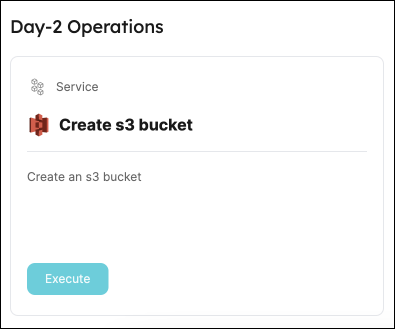
- 点击 "执行"。
- 输入 s3 存储桶的名称并选择可见性,从列表中选择任何服务并点击 "执行"。弹出一个小窗口,点击 "查看详情":

3.该页面提供了有关操作运行的详细信息。我们可以看到,后端返回了 "成功",拉取请求已成功创建:
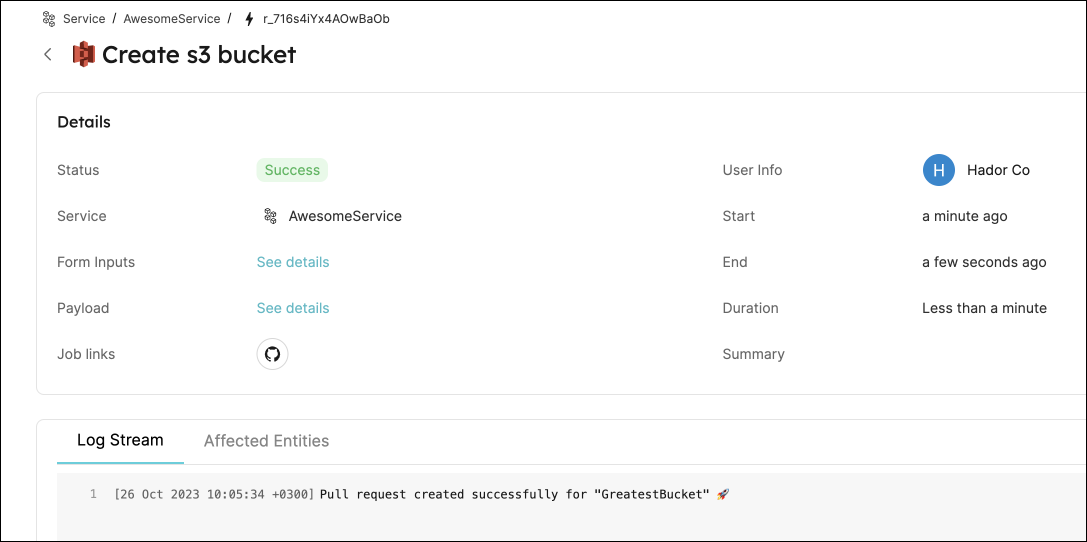
从 Port 访问水桶的定义
您可能已经注意到,即使我们更新了服务的 "资源定义 "URL,它仍然指向一个不存在的页面。 这是因为我们的资源库中还没有任何资源,让我们来解决这个问题:
- 合并拉动请求。
- 转到为其执行操作的服务的实体页面:
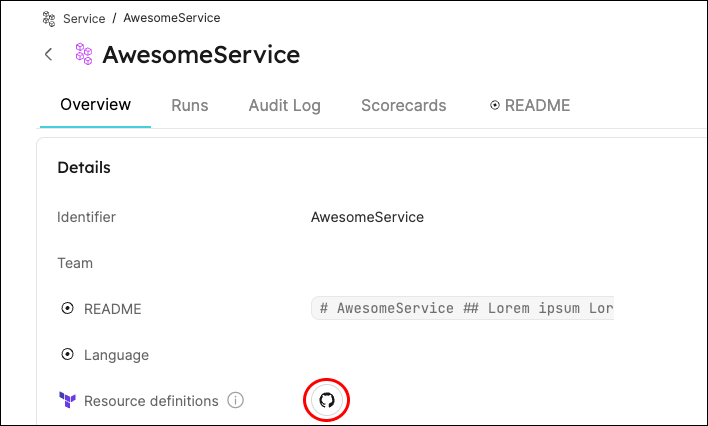
3.单击 "资源定义 "链接,访问服务资源。
全部完成!现在您可以直接从 Port 💪🏽 为您的服务创建资源了
可能的日常整合
- 向组织中的相关人员发送松弛消息,通知新资源。
- 向经理/开发人员发送周报/月报,显示该时间段内创建的新资源及其 Owner。
结论
开发人员门户需要支持并与 git-ops 实践无缝集成。 开发人员应能独立执行常规任务,而不必在组织内部造成瓶颈。 借助 Port,平台工程师可以为开发人员设计精确灵活的自助操作,同时与多种不同的后端集成,以满足您的特定需求。
更多相关指南和示例: